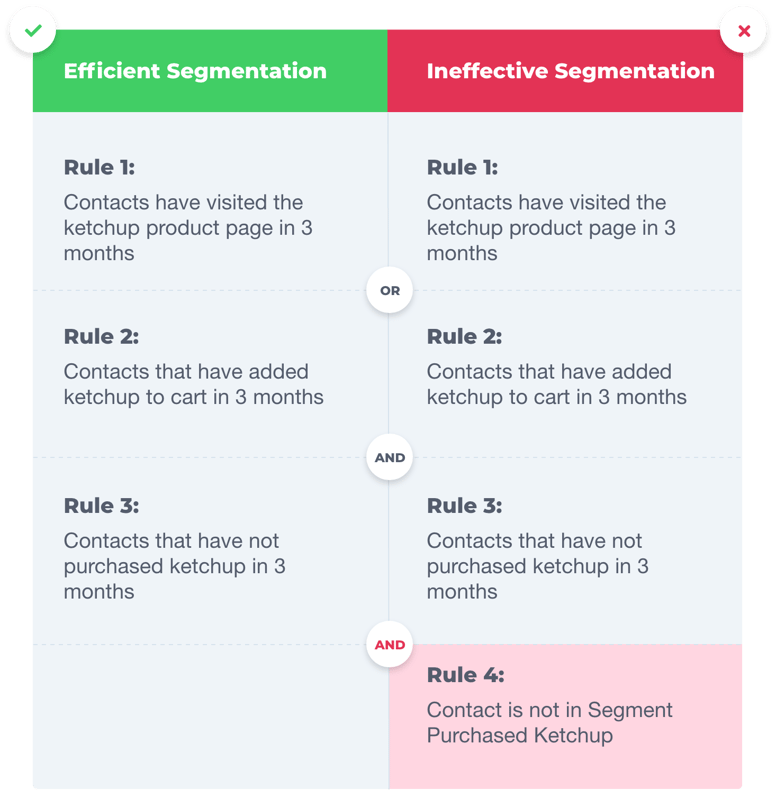Let’s talk about customer segments.
Segments allow you to learn more about your audience demographic, personalize content to increase engagement, and leverage the knowledge of where your audience has been and what they have done to move them to the next appropriate action.
To show the power of segmentation, let’s take the classic abandon cart campaign as an example. Abandon cart campaigns are possible by creating segments of customers who have taken some action, and curating messaging that encourages that segment to followed through. On average, 50% of abandon cart recipients result in a purchase.
While segments are powerful, they do take time to set up and a significant amount of computational power to put together.
To increase your return on the time and computational power segments require, it’s important to create segments with a purpose.
Too much segmentation can cause your business more harm than benefit! Here are 3 ways your hyper-segmented campaigns can be negatively impacting your performance and what you can do about it:
- Your Segments are Not Providing Business Insights and Lead You Astray
- Your Segment Contains a Segment
- Maintaining Segments Is Costly
1. Your Customer Segments are Not Providing Business Insights and Lead You Astray.
Customer segments allow you to identify and cluster your audience members who have similar needs. As a business, there is a greater benefit in finding more commonalities among customer needs rather than just differences. Finding insights that help address the “big picture” allow you to capture more of the market with less work.
If your audience is segmented into thousands of various groups with different positioning and messaging around your product, your brand will get lost in translation. Micro-level insights provided by small segment groups can often lead your team down a rabbit hole with no return.
2. Your Customers Segment Contains a Segment
Repeating redundant segments (like having a segment nested within another segment) only increases the required computing capacity without increasing the output. It’s very important to take the time to map out the logic of a segment before jumping into your marketing platform to set it up. Creating segments with “catch all” rules will severely hinder performance and over complicate things.
Let’s look at two examples of setting up an abandoned cart campaign for Ketchup.

Meaningful segments that provide insight on your target audience or encourage a contact to take the next desired step can usually be found through 25 rules or less. Additional, efficient segments with fewer rules take less time to compute and therefore do not cause delays in a campaign being sent or reports on the segment to be compiled.
3. Maintaining Customer Segments Is Costly
As your number of segmented lists grow, each with their own niche positioning and messaging, taking a new product, service or offer to market will take exponentially more time. No marketer likes to be the last to market. Updating 5 different landing pages and campaigns is much easier than updating 5000!
So, how can you segment with purpose? Follow these 4 steps:
1. When considering creating a segment, personify the segment.
Give each customer segment an identity. When adding a new segment, ask to yourself ‘Does this segment seem like it would be friends with another segment?’. If the answer is yes, these segments have more in common than they have differences it’s probably not worth the effort to single out. Personifying your segments will also help with positioning and messaging when bringing a new product or service to this group.
2. Take the time to map out the logic.
Before you log-in to your marketing platform to create the segment, think through and map out the logic. Having someone review, check or talk through your logic in setting up the rules of the customer segment avoids creating inefficient or redundant segments. Having clear logic laid out also makes maintaining and adjusting a segment easy for the entire team.
3. Set expectations for your segment.
With each campaign, product or new offer you should have a clear expectation on how each of your customer segments will react and perform. If you cannot clearly predict, test and validate the reaction of a segment this is a sign the segment might be too big or too small.
4. K-I-S-S
Keep It Simple Silly! Remember that clarity always trumps personalization.

